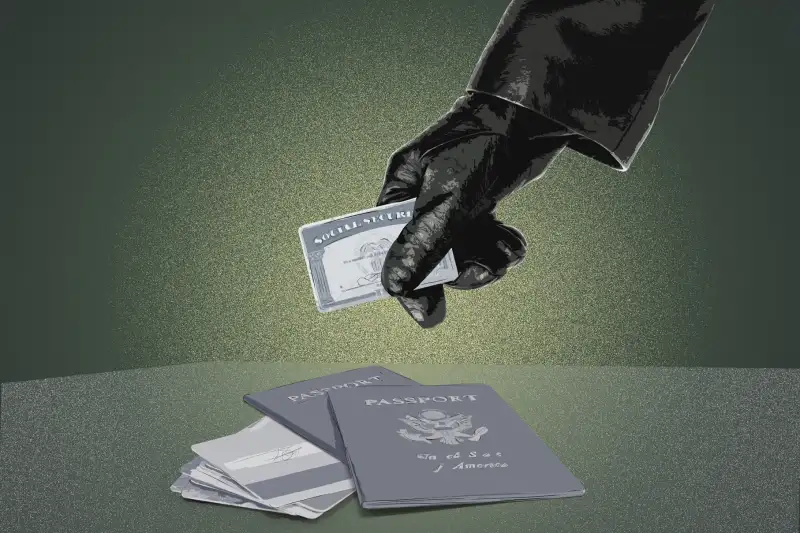How to Protect Yourself from Identity Theft

Identity theft has become increasingly common as people spend more of their lives online. Unfortunately, simple day-to-day things like checking your credit card balance or logging into your favorite coffee shop's Wi-Fi can make you vulnerable.
Identity theft, also known as identity fraud, is a crime where someone uses your personal data – such as your address, birthdate or credit card number – and in doing so causes you personal or financial harm. There are identity theft protection services to help you keep track of your credit accounts and other personal information, but we also suggest you take certain steps to prevent becoming a victim.
Read on to learn how to protect yourself from identity theft and what to do if your personal information ever gets stolen.
Table of Contents
- How to prevent identity theft
- Eight types of identity theft
- What are the signs of identity theft
- How to report identity theft
- How to recover from identity theft
- How to protect yourself from identity theft FAQ
- Summary of How to Protect Yourself from Identity Theft
How to prevent identity theft
Preventing identity theft may not be entirely possible since most people's private and financial information is stored and shared digitally. Once you share your information with a company or government entity, it's their responsibility to keep it safe from cybercriminals.
Although there aren’t any guaranteed ways to prevent identity theft, there are some steps you can take to minimize your risk or catch it early on:
1. Secure your Social Security card and other sensitive documents
Don't carry your Social Security card, birth certificate and passport in your purse, wallet or car unless necessary. Whenever you do, don't leave the documents unattended. At home, consider keeping the documents in a safe in case there’s a burglary.
2. Don’t share sensitive information (unless necessary)
Don’t share your Social Security number, debit card pins, driver's license, birthdate and other sensitive information through phone calls, text messages, email or social media. If you receive a phone call or email from a bank or other financial institution, make sure their contact information is valid before sharing any details.
For example, check the sender's full address if you receive an email from your bank requesting information under the pretext of updating your account. A scammer's email will usually include an extra letter, number or word when compared to the email of the legitimate company. The body of the email might have typos and other grammatical errors as well.
If you receive this type of e-mail, even if it seems legitimate, it's best to go directly to your account's website yourself, instead of clicking on any links provided in the message.
Also, keep in mind that government agencies like the IRS, for example, will never contact you by calling or texting to request personal information or threaten legal action against you.
3. Review your credit report regularly
Reviewing your credit report can help you spot inaccurate information like new accounts you didn't open or any hard inquiries — credit checks associated with loan or credit card applications.
You have the right to an annual credit report from each of the major credit bureaus — Equifax, Experian and TransUnion. However, due to the financial hardships the Covid-19 pandemic has brought for many people, free credit reports will be available weekly until further notice. You can request your free copy through AnnualCreditReport.com.
4. Take advantage of credit freezes and fraud alerts
A credit freeze prevents new accounts from being opened in your name until you lift the freeze. Credit bureaus will provide you with a unique PIN or password you can use to unfreeze your report as needed. If you’re interested in this option, make sure to read our step-by-step guide on how to freeze credit.
You should also consider setting up a fraud alert with each credit reporting agency. These alerts require creditors to contact you (usually by phone) and verify your identity before opening new credit lines or accounts in your name.
Both credit freeze and fraud alerts are free, and can be set up simultaneously.
5. Monitor monthly bills
Check your credit card and bank statements for unauthorized charges. If you do spot any suspicious activity, contact your bank or credit card company immediately. They may stop the fraudulent transaction, cancel the compromised account, and prevent damage to your credit.
6. Use strong passwords and a password manager
Avoid using sequential letters and numbers ("1234" or "abcd") and personal information in your passwords. Instead, use a strong password that includes 12 characters or more and combines random numbers, symbols and letters (uppercase and lowercase).
Also, it's crucial never to reuse passwords across your accounts. If hackers acquire a reused password in a data breach, it could give them access to all accounts sharing the same login credentials.
Most people find that coming up with dozens of unique passwords and remembering them can be a hassle. If that’s the case, a password manager software could help — these programs generate passwords for you and store them in encrypted formats that are almost impossible to decipher.
7. Set up an IRS PIN
An IRS PIN (also known as an Identity Protection PIN) is a six-digit number assigned to taxpayers that helps prevent someone from using your information to file a fraudulent tax return. The IRS won't accept tax forms in your name unless the code is provided as well. You can request your PIN from the IRS website.
8. Enable two-step authentication
Two-step authentication (also called two-factor authentication or 2FA) provides an extra security safeguard to your usual password. When enabled, it requires you to enter a code after you input your password. The code changes each time and you’ll receive it either through an email, call or text message. If someone tries to access your account, they won't be able to without the one-time code.
9. Install an antivirus software
Identity thieves may try to breach your Wi-Fi network, computer or smartphone if they're not secured. An antivirus software can detect and remove malicious software (malware) designed to to steal data. This software also scans emails attachments, apps and other downloaded files for potential viruses.
10. Consider using a virtual private network (VPN)
Public Wi-Fi networks can be risky as they generally offer little protection and hackers could intercept your online activity. A virtual private network (VPN) can protect your sensitive information as you surf the web in your favorite coffee shop or library, for example. When you connect to a VPN, the software encrypts and shields your mobile device’s online activity.
11. Shred important documents
Some identity thieves still rely on old-fashioned methods such as dumpster diving for credit card and loan offers, bank account statements, utility bills or medical bills. You should shred every document containing personal information before disposing of them. Consider buying a paper shredder since a scammer may reconstruct a manually ripped paper.
12. Collect your mail daily
Fraudsters may steal your mail to get your name, date of birth, email address, phone number and other identifying information. Collect your mail every day and if you're going on vacation, contact your local post office to place up to a 30-day hold on your mail. You can make the request online at USPS.com.
Eight types of identity theft
Identity thieves can use stolen information in several ways. While many may think that criminals use your personal information to open new credit card accounts or apply for loans, in reality this is just the tip of the iceberg.
Yes, financial identity theft is one of the most common types, but criminals use stolen personal data to receive medical services, apply for employment and even get their hands on your tax refund. Let’s go over the most common eight types:
1. Financial identity theft
Financial identity theft refers to instances when a person uses your data for financial gain. For example, a scammer might apply for a new credit card or loan, open a bank account or use your debit card to make an unauthorized purchase.
2. Employment identity theft
Scammers may use your Social Security number or other personal information in order to obtain employment. This can happen when the person has a criminal record or a poor work history and is trying to pass a background check or meet the employment requirements.
3. Medical identity theft
In medical identity theft, an unauthorized person might use your information to obtain health care services or to fill out fraudulent insurance claims. A health care provider may also commit this type of fraud by submitting a claim to your insurance for procedures they never performed. In certain circumstances, this may lead to the criminal’s and the victim's health records getting mixed up, leading to misdiagnosis or inadequate treatment.
4. Account takeover fraud
Account takeover fraud, or credential theft, happens when someone gains access to one of your social media, financial or other online accounts. The person then makes unauthorized transactions — like withdrawing money or opening a credit card — or gathers more information to access other accounts.
5. Tax identity theft
Tax identity theft happens when a criminal uses your information to file a fraudulent tax return and collect the refund before you do. Most people realize they're victims of this fraud when the Internal Revenue Service (IRS) notifies them that more than one tax return was filed using their Social Security number.
6. Synthetic identity theft
Synthetic identity theft involves criminals combining real and fake information to create an entirely new identity — for instance, someone's real Social Security number but combined with a made-up name, date of birth and address. It's also possible for identity thieves to fuse factual information from multiple people to create a new identity.
In most cases, victims of ID theft can spot scams early on by checking their credit report for suspicious activity. However, with this type of fraud, credit reporting agencies could potentially generate a new credit report for the fake identity. Lenders then report financial accounts or loans applied for with the fraudulent identity to the new report, making it harder for victims to realize someone misused their information.
7. Child identity theft
Children are also at risk of ID theft. Scammers may obtain your child's information from school or medical documents and use it to get a credit card or request government benefits, for instance. The individual often doesn't realize they've been a victim of identity theft until they're old enough to apply for student loans or open a bank and get denied due to bad credit or employment history.
8. Criminal identity theft
Criminal identity theft involves a person providing your information (instead of their own) to law enforcement officials when being questioned or arrested. This is a rare circumstance, but it might lead to a warrant or a criminal record in your name.
What are the signs of identity theft
Even if you follow all 12 steps we detailed above to prevent identity theft you can still become a victim. This is because your information often gets into the hands of criminals on the dark web or through scams like phishing emails. Therefore, learning how to check if someone is using your identity and taking immediate action will help you prevent any further damage.
To find out if someone is using your data illegally, check your monthly bills and bank statements. If you notice anything unexpected or unusual in your financial, medical or tax records that is a sign that you may be the victim of ID theft.
We also suggest you request free copies of your credit reports and check these for any unusual changes. If you already have a lot on your plate, you can sign up for a credit monitoring or identity theft protection service that can do the monitoring for you and will notify you of anything suspicious.
How to report identity theft
ID theft victims should report the incident to the Federal Trade Commission (FTC) online at IdentityTheft.gov or by phone at 1-877-438-4338. We recommend filing the report online as you'll get a step-by-step recovery plan and access to pre-written dispute letters for lenders and credit bureaus. You'll also get to track your ID recovery progress.
Filing a police report is also advisable since some lenders might ask for it before closing fraudulent accounts. If your information was stolen online, file an additional complaint with the FBI's Internet Crime Complaint Center (IC3).
To prevent further damage to your credit history, contact Transunion, Experian and Equifax to notify them of the crime through phone or mail at:
TransUnion
Fraud Victim Assistance Department
P.O. Box 2000 Chester, PA 19016-2000
Phone: 800-680-7289
Equifax Credit Information Services
Fraud Victim Assistance Department
Consumer Fraud Division P.O. Box 740256
Atlanta, GA 30374
Phone: 800-525-6285
Experian
National Consumer Assistance
P.O. Box 9554
Allen, TX 75013
Phone: 888-397-3742
How to recover from identity theft
If a criminal used your personal and financial information to make purchases, get benefits, file taxes, or commit fraud, these are the steps you should take:
- Report the fraud to the Federal Trade Commission (FTC) at IdentityTheft.gov and file a police report with your local law enforcement agency.
- Contact banks or creditors to inform them of the fraud and close compromised accounts.
- Request a copy of your credit report from Transunion, Experian and Equifax through AnnualCreditReport.com.
- Review your credit report routinely to make sure new accounts aren’t opened in your name.
- Place a security freeze and fraud alert on your credit report.
- Write letters to the credit bureaus explaining the situation and include a copy of your ID theft report and proof of your identity.
- Update passwords on all your accounts and consider getting a password manager.
- Consider an identity theft protection service or credit monitoring plan.
- Read up on cybersecurity safety and how to protect yourself from becoming a victim of other scams.
How to Protect Yourself from Identity Theft FAQ
How does identity theft happen?
What is a phishing scam?
How do I know if my identity has been stolen?
What do you do if someone steals your identity?
What can you do to protect yourself from identity theft?
Summary of How to Protect Yourself from Identity Theft
- Identity theft is a crime that involves someone stealing and using your information (such as your name, date of birth, or Social Security number) to commit fraud.
- Some signs of identity theft include sudden credit score drops, bills for accounts you don’t recognize, notices from your health insurance mentioning procedures you didn’t receive, among others.
- There isn't a foolproof way to prevent identity theft. However, reviewing your credit report and bank statements regularly, using strong passwords and storing your Social Security card safely are some steps that may minimize your risk.
- Other measures to consider include investing in a password manager, security freezes and/or fraud alerts on your credit report and hiring an identity theft protection company.
- If you detect any unexpected or unusual change in your financial, medical or tax records this may be a sign that your identity was stolen.
- If you’ve already been a victim of identity theft, you should report the crime to the Federal Trade Commission (FTC), file a police report, and contact lenders and the credit bureaus to report any fraudulent accounts.


